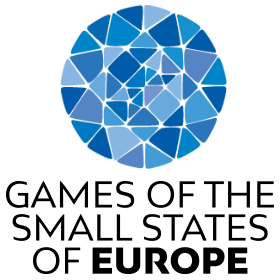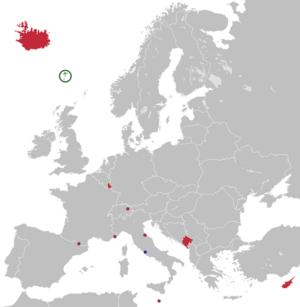Games of the Small States of Europe facts for kids
The Games of the Small States of Europe (often called GSSE) is a big sports event. It happens every two years. The Republic of San Marino started these games. Since 1985, nine small European countries have joined in.
These games usually take place in late May or early June. Athletes compete in nine different sports. These sports are also part of the Summer Olympic Games.
Contents
Countries That Compete
The European Olympic Committees (EOC) help organize these games. When the games first started in 1984, there were eight member countries. In 2009, Montenegro joined, making it nine members.
To be part of the games, a country must have fewer than one million people. Cyprus is the only country that is an exception to this rule. Its population was under one million when the games began in 1984.
Here are the countries that take part:
The Faroe Islands also want to join the games. However, they are not an independent country. They are an autonomous part of Denmark. Also, they are not a member of the EOC.
Past Games and Hosts
The Games of the Small States of Europe have been held many times. Each time, a different member country hosts the event. This table shows where and when the games have taken place. It also shows how many athletes and sports were part of each event.
| No. | Year | Host City | Host Nation | Dates | Nations | Competitors | Sports | Events | Champions |
|---|---|---|---|---|---|---|---|---|---|
| 1 | 1985 | City of San Marino | 23–26 May | 8 | 222 | 7 | 49 | ||
| 2 | 1987 | Monaco City | 14–17 May | 468 | 9 | 66 | |||
| 3 | 1989 | Nicosia | 17–20 May | 675 | 8 | 75 | |||
| 4 | 1991 | Andorra la Vella | 21–25 May | 697 | 8 | 82 | |||
| 5 | 1993 | Valletta | 25–29 May | 690 | 8 | 87 | |||
| 6 | 1995 | Luxembourg City | 29 May – 3 June | 684 | 9 | 88 | |||
| 7 | 1997 | Reykjavík | 2–7 June | 714 | 10 | 87 | |||
| 8 | 1999 | Vaduz | 24–29 May | 566 | 9 | 86 | |||
| 9 | 2001 | City of San Marino | 29 May – 2 June | 658 | 11 | 101 | |||
| 10 | 2003 | Valletta | 2–7 June | 765 | 10 | 105 | |||
| 11 | 2005 | Andorra la Vella | 30 May – 4 June | 793 | 11 | 120 | |||
| 12 | 2007 | Monaco City | 4–9 June | 1062 | 12 | 121 | |||
| 13 | 2009 | Various | 1–6 June | 843 | 9 | 120 | |||
| 14 | 2011 | Various | 30 May – 4 June | 9 | 750 | 9 | 113 | ||
| 15 | 2013 | Luxembourg City | 27 May – 1 June | 762 | 12 | 120 | |||
| 16 | 2015 | Reykjavík | 27 May – 1 June | 789 | 11 | 120 | |||
| 17 | 2017 | City of San Marino | 29 May – 3 June | 889 | 11 | 131 | |||
| 18 | 2019 | Budva | 27 May – 1 June | 846 | 10 | 113 | |||
| Cancelled to avoid scheduling conflict with the rescheduled 2020 Summer Olympics | |||||||||
| 19 | 2023 | Various | 28 May – 3 June | 9 | 835 | 10 | 125 | ||
| 20 | 2025 | Andorra la Vella | 26 May – 1 June | 800+ | 12 | 160 | |||
| 21 | 2027 | Monaco City | Future event | ||||||
| 22 | 2029 | Luxembourg | Future event | ||||||
Sports at the Games
Many different sports are part of the Games of the Small States of Europe. Some sports have different types of events, called disciplines. For example, cycling includes both mountain biking and road cycling. The table below shows all the sports that have been featured. The colors help group similar sports together.
Aquatics Basketball Cycling Gymnastics Volleyball
The planned Games of 2021 were cancelled due to the rescheduling of the 2020 Summer Olympics
| Sport (Discipline) | Body | 85 | 87 | 89 | 91 | 93 | 95 | 97 | 99 | 01 | 03 | 05 | 07 | 09 | 11 | 13 | 15 | 17 | 19 | 21 | 23 | |
|---|---|---|---|---|---|---|---|---|---|---|---|---|---|---|---|---|---|---|---|---|---|---|
| Swimming (records) | LEN | • | • | • | • | • | • | • | • | • | • | • | • | • | • | • | • | • | • | • | ||
| Synchronized swimming | • | |||||||||||||||||||||
| 3-on-3 basketball | FIBAE | • | ||||||||||||||||||||
| Basketball | • | • | • | • | • | • | • | • | • | • | • | • | • | • | • | • | • | |||||
| Mountain biking | UEC | • | • | • | • | • | ||||||||||||||||
| Road cycling | • | • | • | • | • | • | • | • | • | • | • | • | • | • | ||||||||
| Artistic | UEG | • | • | • | • | • | • | |||||||||||||||
| Rhythmic | • | |||||||||||||||||||||
| Beach volleyball | CEV | • | • | • | • | • | • | • | • | |||||||||||||
| Volleyball | • | • | • | • | • | • | • | • | • | • | • | • | • | • | • | • | • | |||||
| Archery | WAE | • | ||||||||||||||||||||
| Athletics (records) | EAA | • | • | • | • | • | • | • | • | • | • | • | • | • | • | • | • | • | • | • | ||
| Boules | CMSB | • | • | • | • | |||||||||||||||||
| Golf | EGA | • | ||||||||||||||||||||
| Sailing | EUROSAF | • | • | • | ||||||||||||||||||
| Judo | EJU | • | • | • | • | • | • | • | • | • | • | • | • | • | • | • | • | • | • | • | ||
| Karate | EKF | • | ||||||||||||||||||||
| Squash | ESF | • | • | • | • | |||||||||||||||||
| Shooting | ESF | • | • | • | • | • | • | • | • | • | • | • | • | • | • | • | • | • | • | • | ||
| Table tennis | ETTU | • | • | • | • | • | • | • | • | • | • | • | • | • | • | |||||||
| Taekwondo | ETU | • | • | |||||||||||||||||||
| Tennis | TE | • | • | • | • | • | • | • | • | • | • | • | • | • | • | • | • | • | • | |||
| Weightlifting | EWF | • | • | |||||||||||||||||||
| Sport (Discipline) | Body | 85 | 87 | 89 | 91 | 93 | 95 | 97 | 99 | 01 | 03 | 05 | 07 | 09 | 11 | 13 | 15 | 17 | 19 | 21 | 23 | |
Medal Winners Over Time
Countries compete to win the most medals. Medals are given for gold, silver, and bronze. This table shows how many medals each country has won in total over all the games.
| Rank | Nation | Gold | Silver | Bronze | Total |
|---|---|---|---|---|---|
| 1 | 555 | 483 | 440 | 1,478 | |
| 2 | 535 | 415 | 449 | 1,399 | |
| 3 | 443 | 447 | 425 | 1,315 | |
| 4 | 163 | 182 | 267 | 612 | |
| 5 | 124 | 198 | 250 | 572 | |
| 6 | 79 | 86 | 113 | 278 | |
| 7 | 76 | 132 | 168 | 376 | |
| 8 | 67 | 37 | 57 | 161 | |
| 9 | 65 | 111 | 153 | 329 | |
| Totals (9 entries) | 2,107 | 2,091 | 2,322 | 6,520 | |
More Sports Events
- Championships of the Small States of Europe
- Island Games
See also
 In Spanish: Juegos de los Pequeños Estados de Europa para niños
In Spanish: Juegos de los Pequeños Estados de Europa para niños



